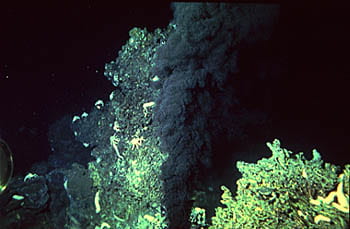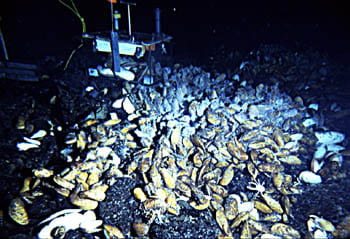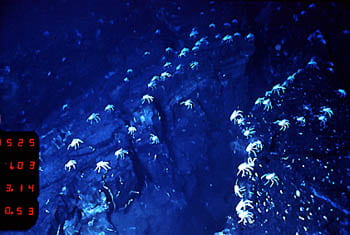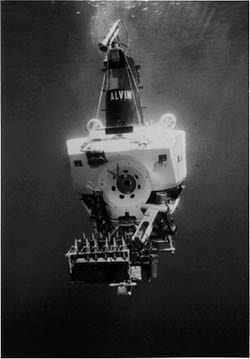The submersible Alvin is beyond amazing. First launched in 1964, it was designed as a miniature submarine, capable of doing small-scale experiments and observations but at great depth, up to about 1500 m. It has been continuously upgraded and designed to function at greater and greater depths. It could exceed 4000m after 1973, and recently has been upgraded again to dive to depths of 6000 m, which gives it access to some very important and poorly understood deep water low oxygen habitats. No one has died using this submarine, although an accident in the late 1960s resulted in the loss of the sub to the bottom. As part of its amazing history, the Alvin was recovered about a year later, along with some lost lunches that led to an astounding discovery of extremely low bacterial activitiy on the deep sea floor. Alvin has had a truly charmed career, populated by scores of deep-sea scientists and even one, Cindy Lee Van Dover, who was trained to be a Navy-capable pilot.
In the 1970s, the submarine Alvin descended to a mid-oceanic ridge to examine the generally steep and rocky bottom environments. The expedition came upon a series of fissures from which spewed hot water of partial volcanic origin. The mid-oceanic ridges are volcanically active, and the molten rock heats sea water in crack systems, often to a superheated state of several hundred degrees. The underwater landscape often consisted of a series of “smoking chimneys” with emanating hot water, loaded with high concentrations of various metals and dissolved sulfide.
These discoveries paled in comparison with the discovery of a fantastic assemblage of animals that were often associated with these hot vents, although in not so hot waters (the animals live in temperatures ranging from cold ambient to over 16ºC). In contrast to adjacent cold-water deep bottoms, the rocky surfaces surrounding the hot vents are covered with animals, including large limpets, clams, and mussels. The most curious and spectacular organism is a large type of tube worm, often 1 m in length, and secretes tubes up to 3 m long. Several species of tube worms have now been discovered and classified in the phylum Vestimentifera, which has affinities to both the Pogonophora and the Annelida.
The community presents a paradox. How can such a productive biota occur in the midst of general poverty? The supply from surface waters is clearly insufficient to maintain these rich animal communities. The dissolved sulfide emanating from the vents seems to be the answer. Certain bacteria derive energy from the oxidation of sulfide. As the sulfide is released from the vent, bacterial populations grow and provide a food source for animals such as bivalve mollusks. Some animals may feed directly on sulfur bacteria from the water column, or may graze on bacteria on surfaces. In the vicinity of the vents, where sulfide-rich water is spewed out, bacteria that derive energy from the oxidation of sulfide live as mats on rocky surfaces and on the surface of soft sediments. These bacteria are probably grazed by a variety of consumers, including crabs, limpets, and bivalves.
Sulfide-dependent bacteria also are found in “bacterial snow” that has been observed in the water column coming from vent waters. This material is also a source of nutrition for consumers. However, many (and perhaps most) vent animals do not seem to feed directly from the external medium. The Vestimentifera, for example, have no obvious gut. Instead, they have a specialized organ, the trophosome, which has dense concentrations of chambers that contain sulfide-oxidizing bacteria. The animal, in turn, can digest the bacteria and derive nutrition. Riftia has a specialized hemoglobin, which binds to both sulfide and to oxygen. The sulfide is transported to the trophosome, where it can be used by the symbiotic bacteria. The bivalve mollusks Bathymodiolus thermophilus and Calyptogena magnifica have sulfur-oxidizing bacteria as symbionts in the gills. The sulfur source is not unique to the deepsea vent animals. Shallowwater animals in sulfide-rich sediments also appear to be festooned with sulfide-oxidizing bacteria, and also derive nutrition from them. There is some evidence that all the bacteria in both deep-sea and shallow-water bivalves belong to the same group of purple bacteria.

Volcanic activity results in superheated water to be expelled from fissures. Here the water is 350 degrees C! Locale is at 21 degrees north on the East Pacific Rise. In 1993-1994 scientists were lucky enough to catch an eruption in action and were able to follow the development of volcanic deposits and biological colonization.

Scientists were able to follow colonization patterns on new volcanic rock. Initially, all that was present were a few mobile animals and large clouds of sulfur bacteria, but large numbers of animals colonized later and grew very rapidly, which is a great contrast with growth rates of animals on the typically trophically depauperate deep sea.

A hot vent fauna, dominated by vestimentiferan tube worms. These worms have been assigned to their own phylum, but they are most closely related to the Pogonophora. They do not feed and depend for their nutrition upon symbiotic bacteria. These bacteria use sulfide, which is delivered to them on special binding sites on the worm’s hemoglobin molecule.
Richard Lutz and colleagues followed a recolonization event of a site covered in volcanic rock and found that worms grew quite rapidly, forming tubes that were over a meter long in one and one half years.

This is a grove of the vestimentiferan worm Riftia pachyptile at the so-called Genesis Site at 13 degrees N latitude on the East Pacific Rise. Such a dense assemblage of invertebrates is found only in areas where sulfur emanates from very nearby hot vents or methane emanates from functionally similar cold seeps.

On a pavement of volcanic rock we find large numbers of the bivalve Calyptogena magnifica. In typical soft bottom deep-sea sites, bivalves and other benthic animals are just a few mm long, but adjacent to hot vents, these bivalve species are quite large, sometime exceeding 20 cm in length. Moreover, growth rates are high.

A bed of the deep-sea mussel Bathymodiolus thermophilus, which has symbiotic sulfur bacteria that obtain their sulfur from the hydrogen sulfide emanating from the vents. The chamber in the background was deployed by the deep-sea submarine Alvin. Although most deep sea bivalves are only a few mm long, these mussels exceed 20 cm in length.

Sulfur bacteria are very abundant, both in the water column and as surface colonies on the rocks near hot vents. These depend on the hydrogen sulfide that emanates in water from the vents. This great snow flurry-like population was found during a volcanic eruption on the East Pacific Rise.

Galatheid crabs are often abundant near hot vents and here we see rows of them lining a fissure at a hot vent on the East Pacific Rise. They may be feeding on surface layers of sulfur bacteria. Such a density of surface-feeding invertebrates would not be found on the open deep-sea floor, except perhaps at rare falls of large carcasses.

The Alvin has been the most central vessel in research on hot vents. It is under the charge of the Woods Hole Oceanographic Institution but is used by scientists throughout the world. Here Alvin is being put over the side from its tending vessel, the R.V. Atlantis II.

The Alvin on a dive. Note the experimental apparatus being carried by her movable arm. This submersible is capable of collecting samples and placing them in an external box, which is brought to the surface and emptied. It is also possible to implant recording devices in field experiments, such as thermistor probes.
